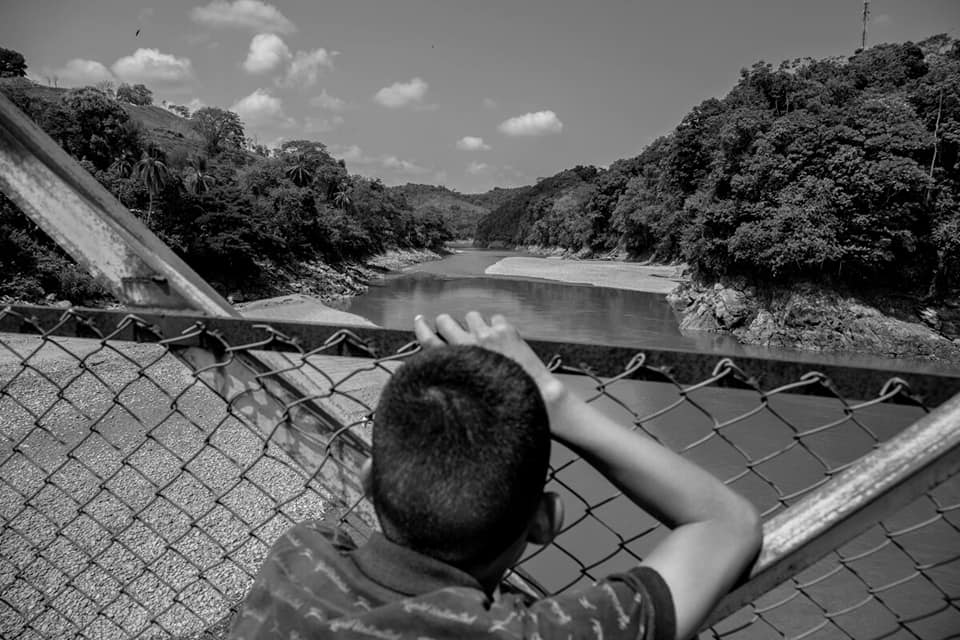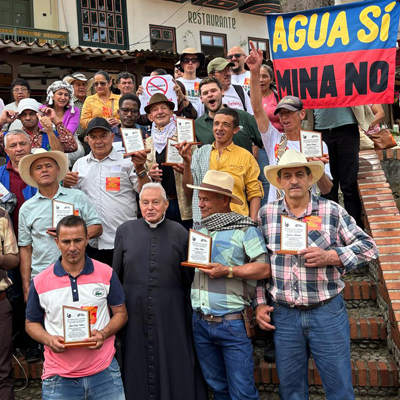Until the river is killed
Ríos Vivos Colombia denounces the drying of the Cauca River by Hidroituango. They call for a national mobilization on February 14.
 A child observing the dried Cauca River. Ph.: Ríos Vivos Colombia/Facebook.
A child observing the dried Cauca River. Ph.: Ríos Vivos Colombia/Facebook.
EPM, the public utility service company of Medellin in charge of the construction of Hidroituango, the hydroelectric project in Ituango, municipality of Antioquia, on February 5 closed some gates of the dam, disrupting the bed of the Cauca river and affecting its flow for four days, killing thousands of fish.
The Cauca River runs through about 180 municipalities in the departments of Cauca, Valle del Cauca, Risaralda, Caldas, Antioquia, Sucre and Bolívar. It is the second longest river in Colombia and one of the main water arteries of the country. “It is a historical heritage of the country,” as called by Juan Pablo Soler, a member of the National Coordination of the Movement of People Affected by Dams Rios Vivos Colombia.
Ríos Vivos Colombia stressed that this drying of the river is a consequence of the damage caused by the reservoir of the dam in Ituango and its surroundings, upstream and downstream, and demanded once more the “controlled dismantling” of Hidroituango.
In the four days that the dam stopped the flow of the Cauca River, it is estimated that around 36,000 fish have died and at least 10 million people living along the river have seen their livelihoods affected, such as the canyon inhabitants, placer miners and fishermen.
To this it must be added the disinformation around the project that EPM has been controlling for 15 years. Neither the National Agency of Environmental Licenses (ANLA) nor the communities near the construction are notified in a timely manner of the decisions made by the company.
Brief summary
In 2014, this river, which had an average of 1000 cubic meters per second, was diverted and piped, which caused the first environmental damage. That is why Rios Vivos says that Hidroituango is a project that has been “full of challenges, contradictions and flaws”.
Last April, during the rainy season, there were several floods upstream and more drought downstream, since the company in charge of building the dam (EPM) had not collected the forest waste –branches, trunks, leaves– that plugged the outlets of the current in the tunnels. In May, this blockage caused landslides in the mountains and the collapsing of one of the tunnels of the dam, so dozens of placer miners communities had to self-evacuate trying to save themselves from the floods. Since Ríos Vivos Colombia’s reports of these socio-environmental impacts were undeniable, the governor of Antioquia had to declare a public calamity in the area.
This humanitarian catastrophe is the result of an energy model “mediated by profit, by the haste to generate dividends, by the pride of imposing technique upon rationality”, which silences the voices of the communities that know the dynamics of the territories. According to Ríos Vivos, this highlights the need to carry out a “fair energy transition”.
This week, EPM reopened the floodgates and the Cauca River will be able to recover its flow little by little, but it will not have the same flow as before. Ríos Vivos Colombia says that this is not enough: “It is a more complex problem than recovering the flow. Today the impact is the drying, but communities and academic experts have pointed out that there may be other contingencies later,” said Soler to RWR, due to the characteristics of the land, its geological faults and the consequences of a work of this magnitude in these lands.
Soler continued: “The problem should be addressed in a structural way and there is a need for alternative options to this energy model commanded by profit”, recalling the proposal of the movement to create a National Commission of Dams as a context where civil society, the government and the business sector can discuss public energy policies in Colombia.
Why did they close the floodgates?
A document from the contractor Consorcio Generación Ituango Integral, which conducted feasibility studies and advised on the construction of the hydroelectric plant, warned the director of the Hidroituango project on February 4 that the structure of the dam was in a “critical condition” and presented “significant cracks” due to the level of the reservoir until that moment. That information would have been the reason why the company decided to close the gate, retaining the normal course of the Cauca River, under the excuse of “protecting human lives downstream of the project first, which implied a huge legal and ethical dilemma, due to the impact that was going to have on the environment,” they said, according to the news outlet Noticial Caracol. However, experts warned that the cracks could break and cause new landslides and floods.
Colombian President Iván Duque said the national government is not to blame for what happened. In the framework of a community workshop that took place in the area of La Mojana, which is drying up due to the lack of the Cauca waters, the president said he “feels pain” for the environmental situations in Ituango, and that what happened will be analyzed and investigated by the environmental authorities, but that the government will not stop the project for the time being.





